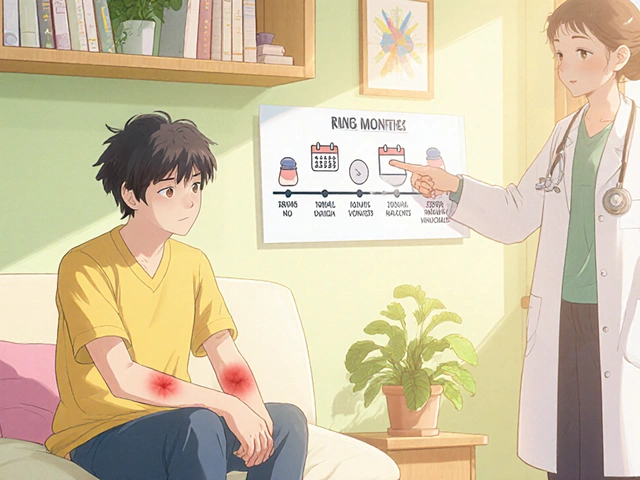
Folic Acid Dosage Calculator
Dosage Calculator
Recommended Dosage
Select your factors above to see your recommended dosage range.
Important: This tool provides general guidance only. Always consult with a healthcare provider before starting any supplementation. High doses of folic acid can mask vitamin B12 deficiency, which may lead to neurological damage.
When you hear the term folic acid supplements are synthetic forms of vitamin B9 designed to boost the body’s folate levels, you probably wonder if a simple pill can fix a blood disorder. The short answer is: they can, but only under the right circumstances. Let’s break down what megablastic anemia is, why folate matters, and how to use supplements safely.
Key Takeaways
- Megaloblastic anemia is a type of anemia caused by impaired DNA synthesis, most often due to a lack of folate or vitamin B12.
- Folic acid supplements are effective when the anemia stems from folate deficiency, not when B12 is the culprit.
- Typical adult dosage ranges from 0.4mg (dietary recommendation) to 5mg (therapeutic) daily, but a doctor should set the exact amount.
- Side effects are rare but can include masking B12 deficiency, which may lead to neurological damage.
- Whole‑food sources (leafy greens, legumes) complement supplements and improve overall health.
Understanding Megaloblastic Anemia
Megaloblastic anemia is a blood condition where red blood cells grow larger than normal and have an immature nucleus. The name comes from "mega" (large) and "blast" (immature cell). Because DNA synthesis stalls, the bone marrow releases these oversized cells into circulation, and they can’t carry oxygen efficiently.
The hallmark lab findings include a high mean corpuscular volume (MCV), low hemoglobin, and hypersegmented neutrophils. Patients often report fatigue, shortness of breath, and pale skin. If left untreated, the lack of oxygen can affect every organ.
Why Folate (Vitamin B9) Matters
Vitamin B9 (folate) is a water‑soluble vitamin crucial for converting single‑carbon units into DNA building blocks. In the bloodstream, folate exists as tetrahydrofolate, which donates methyl groups during the synthesis of thymidine-a nucleotide essential for DNA replication.
When folate levels dip, the body can’t finish the DNA chain, leading to the giant, under‑developed red cells seen in megaloblastic anemia. This is why restoring folate quickly can reverse the problem.

Common Triggers of Megaloblastic Anemia
Not every case is due to a lack of folate. Below is a quick comparison of the two main culprits.
| Feature | Folate‑Deficiency | Vitamin B12‑Deficiency |
|---|---|---|
| Typical MCV | 100‑110fL (macrocytic) | 100‑115fL (macrocytic) |
| Neurological Symptoms | Rare | Common - tingling, gait issues |
| Response to Folate | Rapid correction | Minimal; B12 needed |
| Common Causes | Poor diet, malabsorption, alcohol, certain meds | pernicious anemia, gastrectomy, vegan diet |
| Lab Marker | Low serum folate, normal B12 | Low B12, normal/low folate |
When Folate Supplements Are the Right Choice
If blood work shows low serum folate and normal vitamin B12, folic acid supplements are usually the first line of therapy. Doctors often start with 1mg to 5mg daily for a few weeks, then taper to the recommended dietary allowance (0.4mg) for maintenance.
People at higher risk include:
- Pregnant or planning to become pregnant - folate prevents neural‑tube defects.
- Individuals with chronic alcohol use - alcohol interferes with folate absorption.
- Patients on antiepileptic drugs (e.g., phenytoin) or methotrexate - these can deplete folate.
- Those with malabsorptive conditions like celiac disease.
In these cases, a healthcare provider may prescribe a higher therapeutic dose, often 5mg, to quickly replenish stores.
Choosing the Right Supplement Formulation
Folic acid comes in several formats:
- Tablets - most common, easy to swallow, stable shelf‑life.
- Capsules - sometimes combined with other B‑vitamins.
- Liquid drops - useful for children or adults with swallowing difficulties.
- Multivitamin blends - contain folic acid plus iron, B12, vitamin C; good for broad nutritional gaps.
When selecting, look for a product that lists the exact amount of folic acid (in micrograms) on the label and is free from unnecessary fillers. Third‑party testing stamps (e.g., USP, ConsumerLab) add confidence.

Safety, Interactions, and When to Seek Professional Help
Folic acid is generally safe, but there are a few caveats:
- High doses can mask a concurrent vitamin B12 deficiency, allowing neurological damage to progress unnoticed.
- People on chemotherapy agents like methotrexate should coordinate supplement use with their oncologist, as folate can interfere with treatment efficacy.
- Those with seizure disorders should discuss dosing with a neurologist, because abrupt changes in folate levels may affect seizure thresholds.
Always confirm a diagnosis with a blood test before self‑prescribing. If you notice persistent fatigue, numbness, or mood changes after starting a supplement, book an appointment.
Boosting Folate Naturally: Food First
While supplements are a quick fix, whole foods deliver folate alongside fiber, antioxidants, and other nutrients. Top sources include:
- Spinach and other dark leafy greens - about 58µg per cup cooked.
- Lentils - roughly 180µg per half‑cup.
- Asparagus - 134µg per half‑cup.
- Avocado - 81µg per fruit.
- Fortified cereals - often 100‑200µg per serving.
Including a variety of these foods each day can help maintain adequate folate levels and reduce reliance on pills.
Frequently Asked Questions
Can I take folic acid without a prescription?
Yes, low‑dose folic acid (up to 0.8mg) is available over the counter. However, if you suspect megaloblastic anemia, you should get blood work done first. A doctor can advise the correct therapeutic dose and monitor for B12 masking.
How fast will my anemia improve after starting supplements?
Most patients see a rise in hemoglobin within 1‑2weeks, and red‑cell size normalizes within a month if the deficiency is the only issue.
Will folic acid help if my anemia is caused by vitamin B12 deficiency?
No. B12 deficiency requires cyanocobalamin or methylcobalamin injections or high‑dose oral B12. Giving folic acid alone may improve blood counts but won’t fix the underlying neurological risk.
Are there any side effects of high‑dose folic acid?
High doses are generally well‑tolerated. Rarely, people report nausea, loss of appetite, or sleep disturbances. The biggest concern is hiding a B12 deficiency, so regular monitoring is key.
Can I get enough folate from food alone?
For most healthy adults, a balanced diet rich in leafy greens, beans, and fortified grains meets the 0.4mg daily recommendation. Pregnant women and people with absorption issues often need the extra boost from supplements.
Putting It All Together
If your doctor has confirmed a folate‑deficiency‑related anemia, adding folic acid supplements to your routine can be a game‑changer. Pair the pills with a folate‑rich diet, keep an eye on B12 levels, and stay in touch with your healthcare provider. With the right approach, you’ll watch your energy return and your blood work normalize in weeks.
20 Comments
Write a comment
More Articles

Norvasc: A Practical Guide to Uses, Side Effects, and Real-World Tips in 2025
Wondering what Norvasc is really like? This article gives you the lowdown on how Norvasc works, why so many Aussies rely on it for their blood pressure, what side effects to expect, and practical tips to take it safely. We’ll dig into the latest science and real-life advice so you get more than just the same-old sheet from the pharmacy. Whether you’re considering Norvasc, already taking it, or just plain curious, you’ll walk away knowing exactly what’s up with this common medication.



Jacob Smith
October 12, 2025 AT 13:26You got this, keep that iron flowin'!